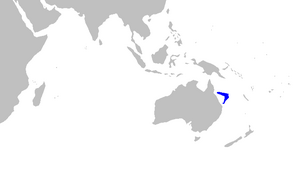Northern sawtail catshark facts for kids
Quick facts for kids Northern sawtail catshark |
|
|---|---|
| Conservation status | |
| Scientific classification | |
| Genus: |
Figaro
|
| Species: |
striatus
|
 |
|
| Range of the northern sawtail catshark | |
The northern sawtail catshark (Figaro striatus) is a type of catshark that lives only in northeastern Australia. It is a bottom-dwelling shark, found deep in the ocean on the upper continental slope. This means it lives where the land slopes down into the deep sea.
These sharks live at depths of about 300 to 420 meters (980 to 1,380 feet). They are small and thin, growing to about 42 centimeters (17 inches) long. The northern sawtail catshark has dark, narrow stripes or saddles along its back and tail. It also has special, enlarged skin denticles (which are like tiny teeth on its skin) along its tail fin and under its tail stem. Scientists don't have enough information yet to know if this shark is endangered.
Contents
About the Northern Sawtail Catshark
Discovering the Northern Sawtail Catshark
Scientists first found specimens of the northern sawtail catshark in the 1980s. This happened during special surveys off the coast of northeastern Australia. At first, they called it Galeus sp. B.
Later, in 2008, three scientists named Daniel Gledhill, Peter Last, and William White officially described the shark. They published their findings through the Commonwealth Scientific and Industrial Research Organisation (CSIRO). In their report, they also brought back the name Figaro for the shark's genus. Before this, Figaro was thought to be the same as Galeus.
The name striatus comes from Latin and means "striped." This refers to the shark's striped pattern. The first shark used to describe the species was a 42 cm (17 in) adult male. It was caught near the Saumarez Reefs in Queensland on November 17, 1985.
Where Northern Sawtail Catsharks Live
The northern sawtail catshark lives only off the coast of Queensland, Australia. Its home range is between the cities of Rockhampton and Townsville.
These sharks prefer to live on or near the bottom of the ocean. They are found in deep waters, usually between 300 and 420 meters (980 to 1,380 feet) down.
What Northern Sawtail Catsharks Look Like
The northern sawtail catshark can grow up to 42 centimeters (17 inches) long. It has a firm, thin body that is mostly round. Its head is short, narrow, and flat, with a blunt snout.
The shark's eyes are oval-shaped and have small, protective third eyelids called nictitating membranes. Below each eye, there is a small ridge, and behind it, a tiny hole called a spiracle. The front edges of its nostrils have triangular flaps that point outwards.
Its mouth is large and curved, with short grooves at the corners. This shark has many rows of teeth, about 65 in the upper jaw and 61–65 in the lower jaw. Each tooth has a main point with 3–5 smaller points next to it. It has five pairs of gill slits.
The northern sawtail catshark has two small dorsal fins (on its back). The first dorsal fin is a bit taller than the second. Its pectoral fins (side fins) are small and wide. The pelvic fins are long and low. Male sharks have special organs called claspers near their pelvic fins. The anal fin (underneath the tail) is long and somewhat angled.
A special feature of this shark is its caudal fin (tail fin). It is short and low, with a small lower part. The shark's body and fins are covered in tiny, overlapping skin denticles. These are like tiny, rough scales. There are unique rows of larger, spiny denticles along the top front part of the tail fin and underneath the tail stem.
The northern sawtail catshark is light grayish-brown on its back and tail. It has 10 to 16 dark brown stripes or saddles before its dorsal fins. Some of these stripes are wider than others. Its sides, underside, and fins are whitish.
Life of the Northern Sawtail Catshark
Reproduction and Growth
Not much is known about how the northern sawtail catshark lives its life. We do know that male sharks become ready to reproduce when they are about 38 centimeters (15 inches) long.
Northern Sawtail Catsharks and People
The International Union for Conservation of Nature (IUCN) has noted that there isn't much fishing happening where the northern sawtail catshark lives. However, they don't have enough information to say if the shark population is healthy or at risk. Because of this, its conservation status is listed as Data Deficient. This means more research is needed to understand its situation.
See also

- In Spanish: Figaro striatus para niños


